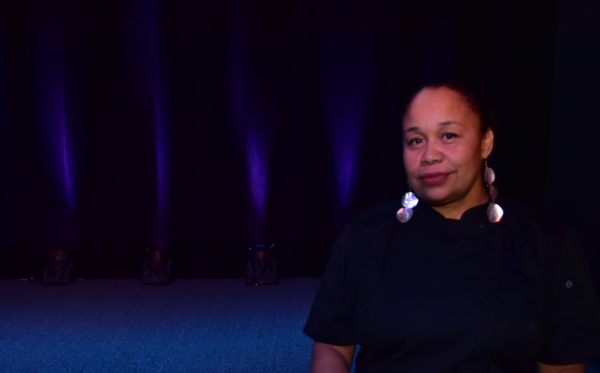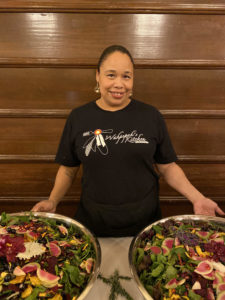
- Details
- By Rich Tupica
SAN FRANCISCO — After Crystal Wahpepah became the first Native American Indigenous chef to appear on the Food Network’s Chopped, it changed her life and solidified her lifelong passion for holistic foods. “It helped tremendously, me going on Food Network,” Wahpepah recalled of her 2012 appearance on the hit television show.
“The feedback from other Native chefs and people in our community, and also my family, helped me grow. It helped me want to pursue it more and more. At the time, I was catering a lot for my community, but as soon as I was on Food Network, I was catering all across the nation.” As the owner of Wahpepah’s Kitchen, a Bay-area catering company, she dishes up authentic recipes inspired by her Kickapoo heritage and often includes Native foods, such as bison, vinson squash and corn. Growing up in Oakland, in the urban Native American community, she was raised alongside people from many different Tribes. All of this is reflected in her vibrant menu. “While I am a member of the Kickapoo tribe from Oklahoma,” she said, “I learned how to cook many styles of Native food and know how our foods bring us together as people.” Over the years, she’s received a list of accolades, including the Indigenous Artist and Activist Award, and being inducted into the Native American Almanac as the first Native American Woman Entrepreneur Catering Business. Now, amidst the COVID-19 pandemic, Wahpepah has temporarily paused daily operations at her thriving catering business. She is instead focusing on other duties and responsibilities, while also looking out for others in her food community. “Right now, people should support Indigenous businesses as much as possible,” she said. Wahpepah recently shared her story, and her business wisdom, with Native News Online. Here’s what she had to say. Also, see the bottom of the story for one of her yummy recipes.
 Crystal Wahpepah (courtesy photo)
Crystal Wahpepah (courtesy photo)
How, when and where did you get interested in food and cooking? I was born and raised in Oakland, California. It just came to me naturally. When I was a child, I was always in the kitchen with my grandmother watching her cook with my grandfather. I probably cooked my first meal when I was 7-years old. I was an odd child (laughs). I loved being in the kitchen. Also, it was my safe haven, you could say. I liked to create. It’s always been a part of me—making Indigenous food. After years of cooking at home, what inspired you to make it your profession? As I grew up, especially in the Bay area, I always wondered why we never saw [Native recipes] as much as we should at restaurants in our Native community. One day, I decided that’s what I wanted to do. It just came really naturally. As for me doing it professionally, I started about 12 years ago, but I’ve been in business officially for 10 years. I decided to go to culinary school and do different entrepreneurial programs. I decided to embrace my craft.
Speaking of your craft, what elements are most important to you when constructing a menu? If you look at my menu, everything represents something from my childhood. So what I mean by embracing my craft, my art, is that when I create traditional food I want people to see how beautiful it is and what it represents. It represents our culture, our community, our family and our ancestors. It represents so many things. When you look at my dishes, you see a lot of corn—that represents my grandmother. We had a lot of corn growing up. Then, if you see berries, it represents some of the beautiful times I had as a child, when I’d pick berries a lot. You see the different colors, what they offer and represent. There is one dish, the Sweet Dried Corn Soup—that is something that was passed down through many generations. I think of my family. I think of my grandparents.
Your Wild Rice Cakes look amazing, where do those come from? That comes from my aunt that lives in Minneapolis, Minnesota. We always had wild rice.
Wahpepah’s Kitchen is catering only, why no brick-and-mortar restaurant location? Right now, at this time [during the COVID-19 Pandemic], I’m glad I don’t. I believe there is a certain time, a certain place for everything. With me, there is so much work to be done being an Indigenous chef. I feel if I sit and plant myself in one spot, I will not finish that work. I cater in the Bay area and across the Nation. There is so much to be said about that. I’ve built a lot of relationships with other Native business owners. We support each other. Yeah, there is a time I’ll want a brick-and-mortar, but at this time, there’s too much other work to be done. I’ve been offered opportunities on many occasions about having a restaurant, but it’s not the right time.
Looking back to 2016, was being on Chopped what you expected? It was intense. I got accepted after five or six interviews. It was very different. It was very competitive, but I didn’t really worry about winning or losing. I was there to represent Indiginous food. I’m a Native chef, our foods are not seen in the mainstream of culinary, so I knew I had a purpose and I feel I did fulfill my purpose. Yes, everybody wants to win, but at the same time I knew I wasn’t going to win. They were serious! (laughs). It made me think, “Man, I should’ve watched this show a little more!”
How has your catering business, and staff of three, been impacted by the pandemic? It put a whole stop to it, when it comes to catering. For Wahpepah’s Kitchen, I do have the option to do pickup or deliveries out of my kitchen. Right now, I’ve just been working on other things. Rescheduling events. I’ve also been helping with the Native American Food Alliance, doing webinars that support other Indigenous chefs. All of us are coming together and supporting each other—helping us get through this.
I’ve been really fortunate having my kitchen, and being able to focus on those types of things. Now, I’m pretty much thinking of the chefs who just started. The ones who started out like me—living day-by-day wondering who’s going to call them for catering. My heart really goes out to them.
For my catering, Wahpepah’s Kitchen has been working at this for a long time. We’ve done some really successful catering events—but all of that has come to a full stop. We were on a really good run! (laughs). So, pretty much I just donated things from my kitchen I knew I couldn’t use and I knew other people and places I knew could use the items. For me, this is pretty much our time to sit back, reflect and see how blessed we are. It’s a good time to embrace your art and learn more about your culture and your food.
There are no doubt some new business owners who are stressing right now, what would you recommend they focus on while the country is at a standstill? The first thing I’d suggest is look for grants, while you apply for a business loan. I’ve been doing two to three grants a day. Hopefully I’ll get one. You can also look into your community and state, you might have a better chance of getting one of those grants because it’s local. However, full disclosure, looking for grants can almost be a full-time job and it can be real hard, especially right now. It’s been challenging to get grants and financial help. I apply for grants with no hits because of the overwhelming demand of small businesses doing the same.
Beyond that, you can find other chefs and help support each other. When you all find out about any non-profit grants, let everyone know. There is a lot of support out there, a lot of resources, but you have to go out and find it.
A recipe from Chef Crystal:
“Here is the recipe for the corn cake we sell out every time at the Indigenous Red Market in Oakland by Urban Native Era.” — Chef Crystal Wahpepah
Roasted Pine Nut Corn Cake
 Roasted Pine Nut Corn Cake (courtesy photo)
Roasted Pine Nut Corn Cake (courtesy photo)
Ingredients:
Cooking spray
1 1/4 cups all-purpose flour
1/3 cup Maple
3/4 cup stone ground yellow cornmeal
2 teaspoons baking powder
1/2 teaspoon salt
3/4 coconut milk
1/4 cup corn oil
1/4 cup roasted pine nuts or any kind
1 cup frozen berries
Notes: Combine corn cake mix, coat large griddle with cooking spray, cook on medium high.
More Stories Like This
Native News Weekly (August 25, 2024): D.C. BriefsUS Presidents in Their Own Words Concerning American Indians
Federal Court Dismisses Challenge to NY Indigenous Mascot Ban
Sen. Angus King Warns of ‘Whitewashing’ History in National Parks Under Trump Administration
Final Call for Donations as CRYP’s 2025 Toy Drive Nears the Finish Line
Help us defend tribal sovereignty.
At Native News Online, our mission is rooted in telling the stories that strengthen sovereignty and uplift Indigenous voices — not just at year’s end, but every single day.
Because of your generosity last year, we were able to keep our reporters on the ground in tribal communities, at national gatherings and in the halls of Congress — covering the issues that matter most to Indian Country: sovereignty, culture, education, health and economic opportunity.
That support sustained us through a tough year in 2025. Now, as we look to the year ahead, we need your help right now to ensure warrior journalism remains strong — reporting that defends tribal sovereignty, amplifies Native truth, and holds power accountable.
 The stakes couldn't be higher. Your support keeps Native voices heard, Native stories told and Native sovereignty defended.
The stakes couldn't be higher. Your support keeps Native voices heard, Native stories told and Native sovereignty defended.
Stand with Warrior Journalism today.
Levi Rickert (Potawatomi), Editor & Publisher
